 |
| September 17, 2019 | Volume 15 Issue 35 |
Designfax weekly eMagazine
Archives
Partners
Manufacturing Center
Product Spotlight
Modern Applications News
Metalworking Ideas For
Today's Job Shops
Tooling and Production
Strategies for large
metalworking plants
DOD: Next-generation air dominance will rely on data sharing -- not new aircraft
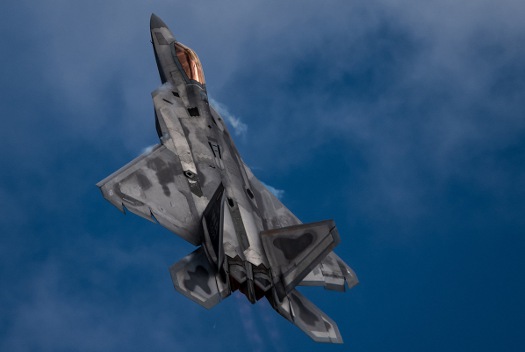
An F-22 Raptor aircraft performs a "tail slide" maneuver during an aerial demonstration at the SkyFest air show in Spokane, WA, June 22, 2019.
By C. Todd Lopez
For about two decades, the U.S. Air Force has fielded both the F-22 Raptor and the F-35 Lightning II -- both billed as technical marvels. But what's next for the Air Force?
Developing what officials call next-generation air dominance likely won't require a new aircraft at all, Air Force leaders have said.
The United States is facing an increasingly competitive global security environment, Air Force Maj. Gen. Michael A. Fantini, director of the Air Force Warfighting Integration Capability, said Aug. 7 at a Mitchell Institute-sponsored panel discussion on next-generation air superiority in Arlington, VA.
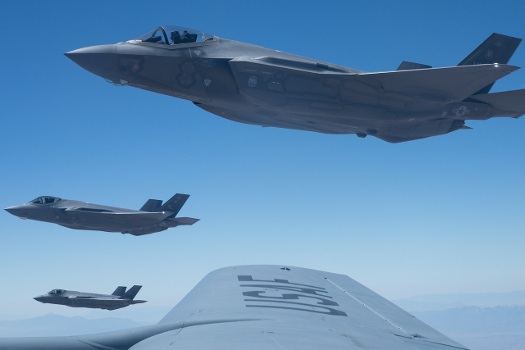
An F-35A Lightning II aircraft conducts air refueling operations with a KC-135R Stratotanker over the Utah Test and Training Range, July 11, 2019.
Nevertheless, he said, the U.S. military will need to continue to execute its core missions of homeland defense and nuclear deterrence. It also will need to be able to defeat a peer adversary while holding another at bay while continuing to engage in countering the violent extremist challenge.
"We will not be able to accomplish that without the ability to continue to control the skies," Fantini said.
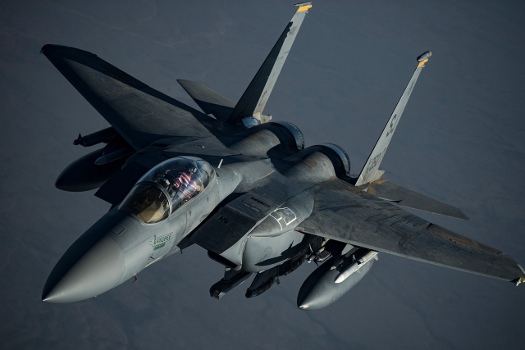
An F-15E Strike Eagle aircraft breaks away after taking on fuel from a KC-10 Extender in U.S. Central Command's area of responsibility, July 10, 2019.
The Air Force's next-generation air dominance program is meant to help it maintain control of the skies -- and that doesn't necessarily mean a new fighter jet, said Air Force Maj. Gen. David A. Krumm, director for Air Force Global Power Programs.
"It is not a thing. It is not a platform," he said. "The next generation of air superiority is a network-connected family of systems that works together to get after the things we need to get after for our nation to ensure air superiority. It's not one thing; it's a multitude of things."
Next-generation air dominance involves ensuring that everything can share data with everything else, across services and across domains, including air, land, sea, space, and cyberspace, Krumm said. "All of that connected is what we want it to be," he added.
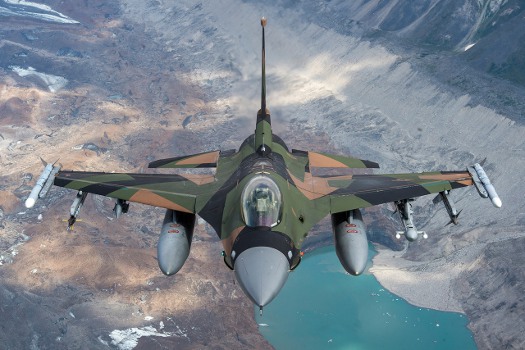
An Air Force F-16 Fighting Falcon flies over the Joint Pacific Alaska Range Complex during training in Alaska, July 18, 2019.
And it takes into account the incredible pace of technology advancement as well, he said, noting that it will be constantly evolving and constantly changing.
The Air Force will look for capabilities that are rapidly upgradable and modular in nature, Krumm said.
Source: U.S. Department of Defense
DESIGN UPDATE SIDEBAR: Air Force aircrew gets new anti-smoke goggles
By Jessica L. Kendziorek, 403rd Wing Public Affairs, Keesler Air Force Base, MS
If smoke starts filling up a C-130J Super Hercules aircraft, the aircrew reach for their anti-smoke goggles (ASGs). For more than 20 years, the ASGs have been a basic four-part system, until now.
With innovation, the new ASGs are now a three-part system. The suspension frame itself is still made the same with the nape pad attached, while the goggles and oxygen mask portion have been upgraded.
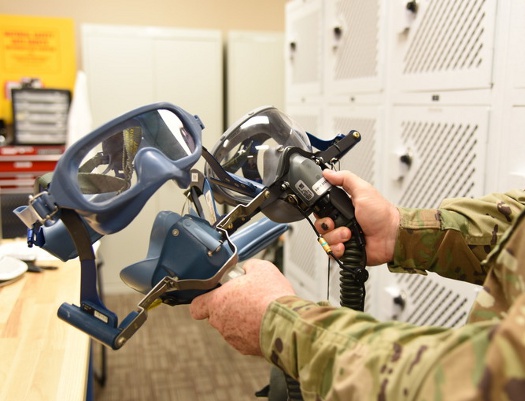
Tech. Sgt. Ronald Patton, 403rd Operation Support Squadron aircrew flight equipment craftsman, shows the difference between the current anti-smoke goggles (left) and the new anti-smoke goggles (right) for the C-130J Super Hercules aircraft, which are replacing the current system that has been used for more than 20 years. The new ASGs are an easier, quick-don system that now has the eyepiece and nose/mouth cover as one single piece similar to those used by firefighters. [U.S. Air Force photo by Jessica L. Kendziorek]
"The ones that we are replacing have the same basic frame, but the goggles and the oxygen mask are two separate pieces," said Tech. Sgt. Ronald Patton, 403rd Operation Support Squadron aircrew flight equipment craftsman. "Before, you would need to put the oxygen mask over your mouth and nose, then pull the frame up and place the nape pad at the back of your head. Once that was in place, you would put the goggles on and pull the straps on both sides to tighten them."
The way the new ASGs work is still the same concept, except now the goggles and oxygen mask are one piece, so when you place the oxygen mask over your nose and mouth, the goggles are put on at the exact same time, saving time and making them quicker to put on and operate.
"The new masks are made similar to ones that firefighters use," said Master Sgt. Ray Reynolds, 403rd OSS aircrew flight equipment (AFE) supervisor. "The older goggles had a narrower field of view, while the new ones allow the aircrew to be able to use their peripheral vision."
As a part of the AFE duties, they are required to make sure the equipment operates the way it is supposed to, be able to fix the equipment, and replace any parts as needed.
Patton said that when the new ASGs came in, the manufacturer sent a "fix" in with the mask to ensure they operated as designed. This fix was a single screw that needed to be replaced on the front of the mask.
"Every part on the ASG system is replaceable, which helps to make sure they last," Reynolds said. "Looking at the order of parts that could be damaged from easiest to hardest, the first thing is the hose, the second thing being the communication cord, and the third is the microphone -- and then onto the remaining parts."
AFE technicians are also required to test the pull disconnect on the air hoses to ensure that they will not come unattached from the oxygen hose on the aircraft too easily. This pull test requires a minimum of 12 lb to a maximum of 20 lb of pull before the hose on the mask would release, ensuring that there is some resistance before it disconnects.
If the disconnect is not between the 12 to 20 lb of pull, then they have to fix the connector to correct the amount of pressure to meet the requirement, Patton said.
"We are also required to conduct pre-flight, post-flight, periodic maintenance, 30-day and 120-day inspections on the ASGs," Patton said.
The 30-day inspections consist of basic checks. A visual examination is conducted and they look for cuts, tears, abrasions, discolorations, rust, anything other than normal, looking for anything that is obviously defective. A cleaning is done, and the components are tested to ensure they work.
The 120-day inspection is the same inspection, but with a full breakdown of all of the components and a deep clean, checking the integrity of the components that you cannot see, Reynolds said.
"It is not that the old ASGs were replaced because they were faulty; they worked exactly as they were designed to. It seems like they just needed to improve on the integrity of the system itself," Patton said. "Will it operate better under stressful situations, will it be easier to repair if it does break, does it have as many subcomponents that can break, does the aircrew member find it easier to don, and can the aircrew operate better in the environment, were questions that they asked when designing the new system."
To improve the ASG system, they took a mask similar to a firefighter's mask and the quick-don suspension frame and made it one system, then they added the communications portion, Reynolds said.
"So they are doing something right, because if they hadn't created this one, the ones that we have still work. I have been in this career field for more than 30 years, and this is only the third version that I have seen," Reynolds said.
"While the older ASG masks still work and some are still located on our C-130J aircraft, we are working to replace them on all of the aircraft," Patton said. "We currently have six sets in service and have replaced more than half of the 815th Airlift Squadron's ASGs with a new quick-don system."
The systems should be on all the aircraft at Keesler AFB this fall.
Published September 2019
Rate this article
View our terms of use and privacy policy
